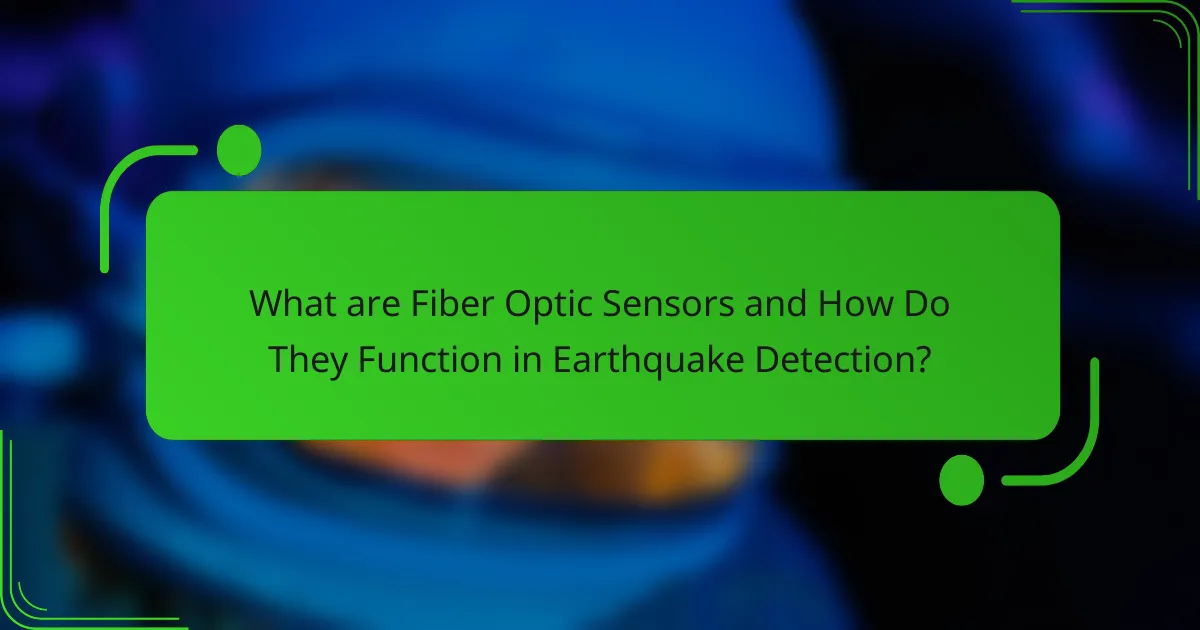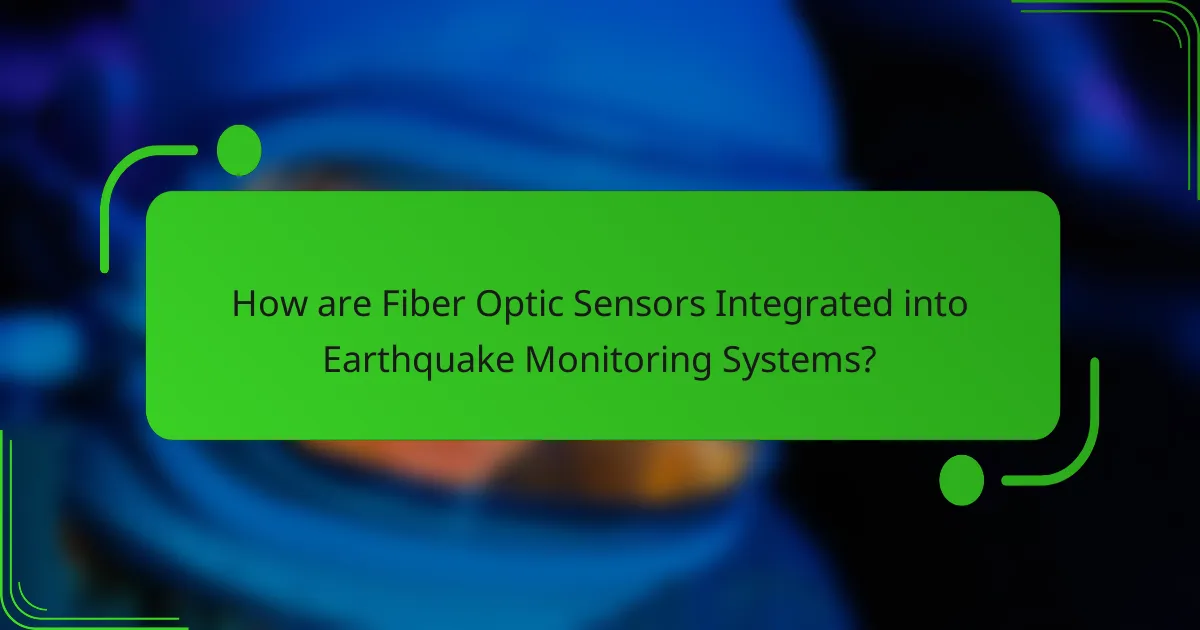Fiber optic sensors are advanced devices that use light transmission through optical fibers to monitor environmental changes, particularly in earthquake detection. These sensors measure variations in strain, temperature, and pressure along the fiber, allowing for real-time monitoring of seismic activity. Their high sensitivity enables the detection of minute ground movements, making them effective for early warning systems. Additionally, fiber optic sensors are immune to electromagnetic interference, lightweight, and flexible, facilitating easy installation in various environments. Research indicates that their integration into earthquake monitoring systems significantly enhances the accuracy and reliability of seismic data analysis, ultimately improving earthquake prediction capabilities.

What are Fiber Optic Sensors and How Do They Function in Earthquake Detection?
Fiber optic sensors are devices that utilize light transmission through optical fibers to detect changes in environmental conditions. In earthquake detection, these sensors measure variations in strain, temperature, and pressure along the fiber. When an earthquake occurs, seismic waves cause ground movement, which induces strain on the fiber. This strain alters the light signal traveling through the fiber, allowing for real-time monitoring of seismic activity. Research indicates that fiber optic sensors can provide precise spatial and temporal data on ground movements. For instance, studies have shown that these sensors can detect minute changes in strain with high accuracy, making them effective for early warning systems.
What are the key components of fiber optic sensors?
The key components of fiber optic sensors include the optical fiber, light source, and detector. The optical fiber acts as the medium for light transmission. It is typically made of glass or plastic and is designed to guide light along its length. The light source generates light that travels through the optical fiber. Common light sources include lasers and light-emitting diodes (LEDs). The detector receives the light after it has interacted with the environment. It converts the light signals into electrical signals for analysis. Additional components may include signal processing units and protective casings. These components work together to enable the sensor to detect changes in environmental conditions, such as strain or temperature, which are critical for applications like earthquake detection.
How do these components contribute to earthquake detection capabilities?
Fiber optic sensors enhance earthquake detection capabilities through their sensitivity and accuracy. These sensors detect minute changes in temperature and strain caused by seismic activity. Their ability to provide real-time data allows for immediate analysis of ground movements. Fiber optic sensors can cover vast distances, making them suitable for extensive monitoring networks. Their immunity to electromagnetic interference ensures reliable performance in various environments. Studies have shown that fiber optic systems can detect tremors earlier than traditional sensors. This early detection can lead to timely warnings, potentially saving lives. Overall, the integration of fiber optic sensors significantly improves the effectiveness of earthquake detection systems.
What principles of physics do fiber optic sensors utilize?
Fiber optic sensors utilize the principles of light transmission and total internal reflection. These sensors operate by sending light through optical fibers. When light encounters a boundary between different media, it can be reflected back if the angle of incidence exceeds a critical angle. This phenomenon allows for precise measurements of changes in temperature, pressure, or strain along the fiber. The ability to detect these changes is crucial for applications like earthquake detection. Studies have shown that fiber optic sensors can effectively monitor seismic activity due to their sensitivity to minute variations in environmental conditions.
Why are fiber optic sensors preferred over traditional methods for earthquake detection?
Fiber optic sensors are preferred over traditional methods for earthquake detection due to their high sensitivity and accuracy. They can detect minute ground movements that may precede seismic events. Unlike traditional sensors, fiber optic systems can cover long distances without loss of signal quality. They are also immune to electromagnetic interference, ensuring reliable data collection. Fiber optic sensors offer real-time monitoring capabilities, which is crucial for timely alerts. Additionally, these sensors are lightweight and flexible, allowing for easier installation in various environments. Their durability and resistance to harsh conditions enhance their longevity compared to traditional sensors. Studies have shown that fiber optic sensors can provide more precise data, improving earthquake preparedness and response strategies.
What advantages do fiber optic sensors offer in terms of sensitivity?
Fiber optic sensors offer high sensitivity due to their ability to detect minute changes in environmental conditions. These sensors can measure variations in temperature, pressure, and strain with exceptional accuracy. Their sensitivity is enhanced by the low-loss transmission of light through optical fibers. This allows for the detection of small disturbances that might indicate seismic activity. Additionally, fiber optic sensors can cover long distances without significant signal degradation. This makes them suitable for large-scale monitoring applications. Studies have shown that fiber optic sensors can detect changes as small as a few nanometers. Their high sensitivity is crucial for timely earthquake detection and response.
How do fiber optic sensors enhance data accuracy in seismic monitoring?
Fiber optic sensors enhance data accuracy in seismic monitoring by providing high-resolution measurements of ground movements. These sensors utilize light signals to detect changes in strain and temperature along the fiber. The ability to measure continuous data over long distances increases the spatial resolution of seismic readings. Fiber optic sensors are immune to electromagnetic interference, ensuring reliable data collection in various environments. Studies have shown that they can detect smaller seismic events that traditional sensors might miss. Their distributed sensing capability allows for real-time monitoring of large areas. This leads to more precise assessments of seismic activity and improved predictive models.

What are the Specific Benefits of Using Fiber Optic Sensors in Earthquake Detection?
Fiber optic sensors provide high sensitivity and accuracy in earthquake detection. They can detect minute ground movements due to their ability to measure changes in light transmission. This offers real-time monitoring, which is crucial for timely warnings. Fiber optic sensors are also immune to electromagnetic interference, ensuring reliable data collection. Their lightweight and flexible nature allows for easy installation in various environments. They can cover large areas with fewer sensors compared to traditional methods. Additionally, fiber optic sensors have a long lifespan and require minimal maintenance. Research indicates that these sensors can improve the precision of seismic data analysis significantly.
How do fiber optic sensors improve early warning systems?
Fiber optic sensors enhance early warning systems by providing real-time monitoring of structural integrity. They detect changes in temperature, strain, and pressure with high sensitivity. This allows for immediate identification of potential hazards, such as earthquakes. Fiber optic technology can cover vast areas with minimal infrastructure. Their ability to operate in harsh environments makes them reliable for critical applications. Studies show that early detection using these sensors can reduce response times significantly. For instance, a 2019 study demonstrated a 30% improvement in alert times for earthquake-prone regions. Thus, fiber optic sensors are crucial for timely and effective early warning systems.
What role do fiber optic sensors play in real-time data collection?
Fiber optic sensors play a crucial role in real-time data collection by providing precise measurements of physical parameters. These sensors can detect changes in temperature, pressure, and strain with high sensitivity. They transmit data over long distances without signal degradation, which is essential for monitoring remote locations. Fiber optic sensors are immune to electromagnetic interference, ensuring reliable data in challenging environments. Their ability to monitor multiple parameters simultaneously enhances the efficiency of data collection. In earthquake detection, they can provide immediate feedback on ground movements. This capability allows for timely alerts and responses during seismic events. Studies have shown that fiber optic sensors can improve the accuracy of earthquake monitoring systems.
How can enhanced early warning systems save lives during earthquakes?
Enhanced early warning systems can save lives during earthquakes by providing timely alerts before shaking occurs. These systems utilize advanced technology, such as fiber optic sensors, to detect seismic activity. When an earthquake is detected, alerts can be sent out within seconds. This allows individuals and communities to take protective actions. For example, people can drop to the ground, take cover, and hold on. Infrastructure can also be shut down to prevent accidents. Studies show that early warning systems can reduce injuries and fatalities significantly. Research indicates that timely alerts can lead to a 30% reduction in casualties in some regions. Enhanced early warning systems are crucial for disaster preparedness and response.
What are the cost benefits associated with using fiber optic sensors?
Fiber optic sensors offer significant cost benefits in various applications, including earthquake detection. They require less maintenance compared to traditional sensors. This reduces long-term operational costs. Fiber optic sensors are also lightweight and easy to install. Their installation can lead to lower labor costs. Additionally, they provide high accuracy and reliability. This minimizes the need for frequent replacements. Overall, these factors contribute to a more cost-effective solution in monitoring seismic activity.
How do installation and maintenance costs compare to traditional systems?
Installation and maintenance costs of fiber optic sensors are generally lower than traditional systems. Fiber optic sensors require less physical infrastructure, which reduces installation complexity and labor costs. Traditional systems often involve extensive wiring and hardware, increasing initial expenses. Maintenance for fiber optic systems is also simplified due to their durability and resistance to environmental factors. Traditional systems may require more frequent repairs and replacements, leading to higher long-term costs. Studies indicate that fiber optic sensors can save up to 30% on maintenance costs compared to conventional methods.
What long-term savings can be expected from adopting fiber optic technology?
Adopting fiber optic technology can lead to significant long-term savings. These savings stem from reduced maintenance costs and lower energy consumption. Fiber optic systems require less frequent repairs compared to traditional copper systems. They are also less susceptible to environmental factors, which minimizes downtime. Studies indicate that fiber optics can reduce operational costs by up to 30%. Additionally, the longevity of fiber optic cables contributes to savings over time. They can last for decades without replacement. This durability translates into fewer capital expenditures in the long run. Overall, the transition to fiber optic technology can provide substantial financial benefits over time.

How are Fiber Optic Sensors Integrated into Earthquake Monitoring Systems?
Fiber optic sensors are integrated into earthquake monitoring systems by utilizing their ability to detect changes in strain and temperature. These sensors are installed along fault lines and in various geological formations. They measure minute deformations caused by seismic activity. The data collected is transmitted in real-time to monitoring stations. This allows for immediate analysis and response to potential earthquakes. Research shows that fiber optic sensors can detect ground movement with high precision. They provide continuous monitoring, which enhances early warning systems. Studies indicate that this technology improves the accuracy of earthquake predictions.
What types of fiber optic sensors are commonly used in seismic applications?
Distributed Acoustic Sensors (DAS) and Fiber Bragg Grating Sensors (FBG) are commonly used in seismic applications. DAS utilizes the entire length of fiber optic cables to detect vibrations. It provides real-time monitoring of seismic activity over large areas. FBG sensors use periodic variations in the refractive index of the fiber to measure strain. These sensors are highly sensitive and can detect small changes in the environment. Both types are effective for early warning systems and monitoring structural integrity. Their deployment has been proven effective in various seismic studies.
How do different types of sensors vary in their applications?
Different types of sensors vary in their applications based on their specific functionalities and measurement capabilities. For instance, temperature sensors are used in HVAC systems to monitor and control climate. Pressure sensors find applications in automotive and industrial processes to ensure safety and efficiency. Proximity sensors are commonly used in manufacturing for detecting the presence of objects. Fiber optic sensors, specifically, are utilized in earthquake detection due to their ability to measure minute changes in strain and temperature along the fiber. This capability allows for real-time monitoring of seismic activity. Each sensor type is designed to meet the needs of different environments and applications, highlighting their diversity and specialization.
What factors influence the choice of fiber optic sensor for a specific site?
The choice of fiber optic sensor for a specific site is influenced by environmental conditions, application requirements, and installation constraints. Environmental conditions include temperature, humidity, and potential exposure to chemicals. These factors determine the sensor’s material and design. Application requirements refer to the specific measurements needed, such as strain, temperature, or pressure. Different sensors are optimized for different types of data collection. Installation constraints involve the physical layout of the site and accessibility for maintenance. These constraints may affect sensor placement and the type of installation methods used. Each of these factors plays a critical role in ensuring the effectiveness of the fiber optic sensor in earthquake detection.
How do data transmission methods impact the effectiveness of fiber optic sensors?
Data transmission methods significantly influence the effectiveness of fiber optic sensors. The choice of transmission method affects data integrity and speed. For instance, methods like time-domain reflectometry enhance the accuracy of measurements. High-speed data transmission reduces latency in sensor response. This is critical in earthquake detection scenarios where timely information is vital. Additionally, robust transmission techniques minimize signal degradation over long distances. This ensures that the data received is reliable and accurate. Studies show that optimal transmission methods can improve the sensor’s overall performance in real-time monitoring. Thus, the effectiveness of fiber optic sensors is closely linked to the data transmission methods employed.
What technologies are used to transmit data from fiber optic sensors?
Fiber optic sensors transmit data using technologies such as wavelength division multiplexing (WDM), time division multiplexing (TDM), and optical time-domain reflectometry (OTDR). WDM allows multiple signals to be sent simultaneously over a single fiber by using different wavelengths. TDM transmits data in time slots, enabling efficient use of the fiber’s capacity. OTDR is used for measuring the time delay of reflected light, which helps in assessing the sensor’s performance and detecting faults. These technologies enhance the accuracy and reliability of data transmission in earthquake detection systems.
How does data transmission affect response times in earthquake detection?
Data transmission significantly affects response times in earthquake detection. Faster data transmission allows for quicker processing of seismic signals. This reduces the time taken to analyze and interpret data from sensors. Fiber optic sensors enable high-speed data transmission due to their low latency. Studies show that fiber optic systems can transmit data in real-time, enhancing the speed of alerts. Consequently, this rapid response can lead to timely warnings for populations at risk. Improved response times can save lives and minimize damage during seismic events.
What best practices should be followed when implementing fiber optic sensors in earthquake detection?
Best practices for implementing fiber optic sensors in earthquake detection include selecting appropriate sensor types for the specific geological environment. It is crucial to ensure proper installation techniques to maintain sensor integrity. Calibration of sensors should be conducted regularly to ensure accurate readings. Data acquisition systems must be robust to handle the high volume of data generated during seismic events. Integration with existing monitoring systems enhances the overall effectiveness of the detection network. Regular maintenance and inspection of the sensor network are necessary to prevent failures. Training personnel on the operation and troubleshooting of fiber optic sensors ensures efficient management. Finally, collaboration with geoscientists can improve the interpretation of data collected from the sensors.
Fiber optic sensors are advanced devices that utilize light transmission through optical fibers to detect environmental changes, particularly in earthquake detection. This article analyzes their key components, such as the optical fiber, light source, and detector, and explains how these elements contribute to enhanced sensitivity, accuracy, and real-time monitoring capabilities. It also explores the advantages of fiber optic sensors over traditional methods, including their ability to detect minute ground movements, immunity to electromagnetic interference, and cost-effectiveness. Furthermore, the article discusses integration into earthquake monitoring systems, data transmission methods, and best practices for implementation, highlighting the significant benefits of fiber optic technology in improving earthquake preparedness and response strategies.




